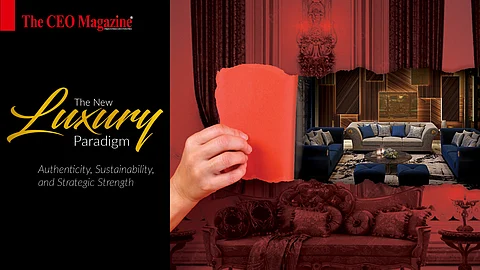
- News
- Women
- Magazine
- IndustryIndustry
- InsightsInsights
- Success Stories
- PublishPublish
- ContactContact
- Media KitMedia Kit

The New Luxury Paradigm
Luxury is undergoing a profound transformation, reshaping how brands create, market, and deliver value to their discerning clientele. The concept of luxury, once narrowly defined by rarity, exclusivity, and opulence, is evolving to embrace a broader, more nuanced understanding that incorporates sustainability, personalisation, and mindful consumption. This shift is not a fleeting trend but marks the emergence of a new era, what many call NEO Luxury, where luxury brands must adapt their strategies to remain relevant and resilient.
Over the past few decades, luxury has experienced two significant shifts. The initial phase, focused on old luxury, emphasised the ownership of exquisite objects and timeless pieces that symbolised wealth and status. About 10 to 15 years ago, the industry transitioned into New Luxury, characterised by democratisation and experiential values, where luxury became more accessible and rooted in personal experiences rather than mere possession.
Today, the luxury sector is stepping into its third evolutionary phase: NEO Luxury. This stage fuses sustainability, digital innovation, and consumer empowerment with the timeless allure of craftsmanship and exclusivity. Luxury is no longer just about the physical product; it embodies ethical responsibility, emotional well-being, and a connection to values beyond material wealth.
Several trends are driving this transformation. Among them:
Sharing and Second-Life Models: Luxury products are increasingly circulated through rental or resale platforms, creating a circular economy that challenges traditional ownership norms.
Digital Innovation Balanced with Detox: While brands are leveraging augmented reality, e-commerce, and digital marketing to enhance the customer journey, there is a counterbalance in consumers’ desire to disconnect from screens and seek authentic offline experiences.
Personalisation and Co-Creation: Customisation is becoming essential, with clients wanting to actively participate in designing or tailoring luxury pieces that reflect their individuality.
Sustainability as a Core Value: Ecological and social responsibility have moved to the forefront, pushing brands to adopt ethically sourced materials and transparent supply chains.
Health and Mindfulness: The integration of well-being, physical, mental, and spiritual, into the luxury narrative reflects a holistic lifestyle approach.
Luxury Casualisation and Democratisation: Streetwear influences and public luxury trends make luxury more approachable, breaking down old boundaries without compromising quality.
Conscious Consumption: A focus on lean luxury encourages mindful purchasing, valuing quality and purpose over quantity.
Together, these trends redefine what it means to be a luxury brand in today’s world, emphasizing values that resonate deeply with modern consumers.
The recent market slowdown in the luxury sector has underscored the need for brands to build strategic resilience. This involves reevaluating traditional business models and embracing adaptability to withstand future challenges.
One critical step is reconnecting with authentic luxury values. Brands are encouraged to empower creative leadership, allowing artistic directors greater freedom and time to develop visionary, distinctive styles. Such authenticity fosters enduring brand identity that does not rely heavily on logos or marketing gimmicks but instead speaks through design excellence and craftsmanship.
Equally important is the shift toward offering luxury products that are genuinely wearable and functional. Moving beyond one-off statement pieces, brands must develop collections that integrate seamlessly into consumers’ lifestyles, reflecting both aesthetic appeal and practical value.
Sustainability innovation plays a pivotal role in resilience. On-demand production models, such as those found in haute couture, significantly reduce waste and reinforce the brand’s commitment to environmental stewardship. This approach aligns with a broader industry move toward transparency and responsible consumption.
Diversification is another pillar of resilience. Luxury brands are exploring segmented product lines and pricing tiers to serve varied customer groups without diluting their core value proposition. Secondary brands or tiered collections enable brands to reach new audiences while maintaining prestige at the top end.
Geographical diversification is also crucial. Emerging markets, particularly India, are poised for rapid luxury growth, though challenges remain in cultural adaptation and regulatory navigation. Strategic local partnerships and market-sensitive approaches will be key to capitalizing on these opportunities.
To successfully navigate this new landscape, luxury businesses should focus on:
Enhancing Digital Capabilities: Leveraging technology to enrich customer experiences while respecting the desire for meaningful offline engagement.
Centred Customer Experience: Deeply understanding and anticipating evolving consumer needs to tailor products and services.
Leading Change Across Generations and Cultures: Implementing management strategies that embrace diverse perspectives and foster agility.
Transforming Business Models: Innovating across product design, marketing, organisation, and sustainability to align with modern luxury values.
Despite clear recognition of these priorities, many brands face an implementation gap, making decisive leadership and focused execution essential.
The future of luxury hinges on harmonising tradition and innovation, exclusivity and accessibility, and sensory delight and ethical consciousness. Iconic brands that maintain rarity, superior craftsmanship, and timeless elegance, while adapting to contemporary values, will continue to lead the market.
For jewellery brands, this means emphasising provenance, responsible sourcing, and meaningful storytelling. Today’s luxury consumers seek pieces that do not just dazzle but also reflect a commitment to the planet and society, offering deeper emotional connection and lasting value.
As the luxury sector welcomes this new era, the brands that cultivate strategic resilience by embedding sustainability, authenticity, and adaptability into their core will not only endure market disruptions but also set new standards for what luxury means in the 21st century.
Follow us on Google News
